What You’ll Need
- Air dry sculpting clay
- A vase
- Paint – Grey or White (or any colour you can imagine!)
We have some spook-tacular Halloween crafts that are sure to haunt your home with fun and festivity! Whether you’re aiming to add a ghostly charm to your indoor plants with a Ghost Vase or a chilling ambiance to your front porch with Creepy Planters, each project is a blend of creativity and delight. Perfect for all ages, these crafts invite you to embrace the playful spirit of Halloween. So, gather your supplies, summon your imagination, and let the Halloween crafting commence!
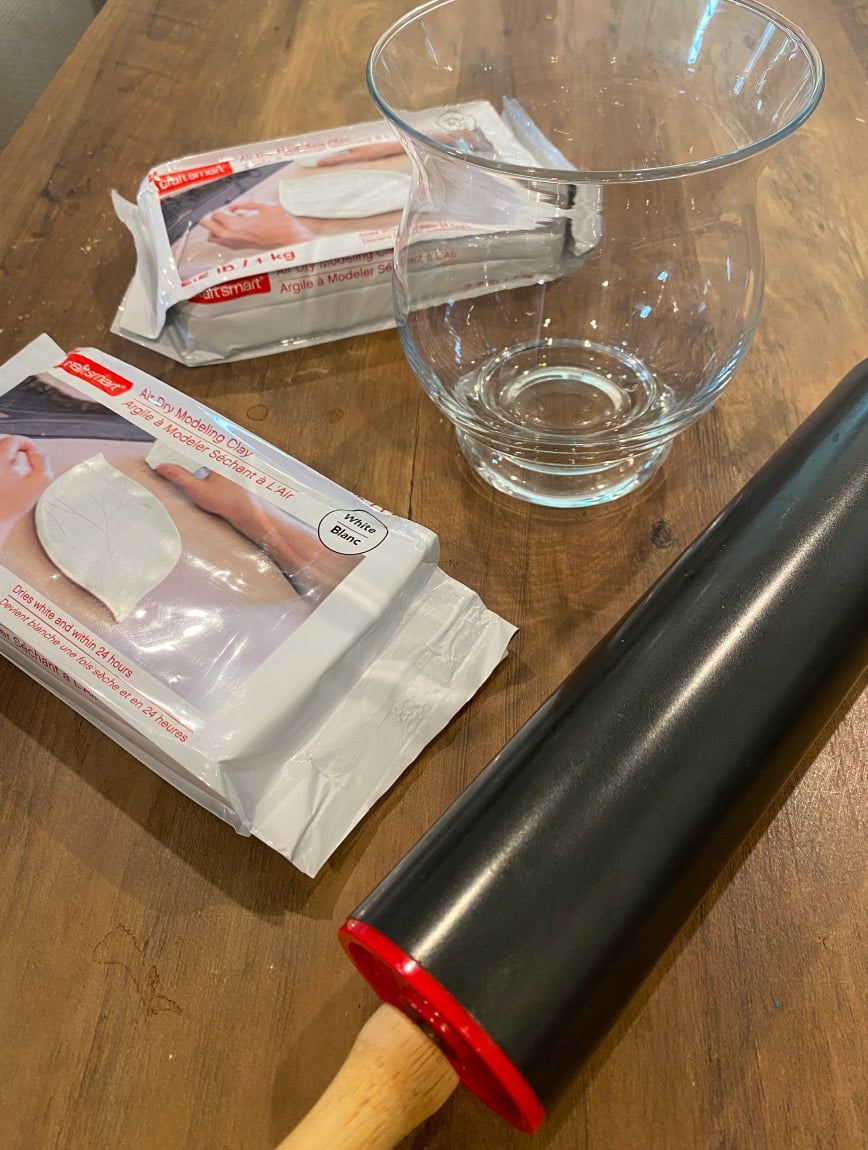
Directions



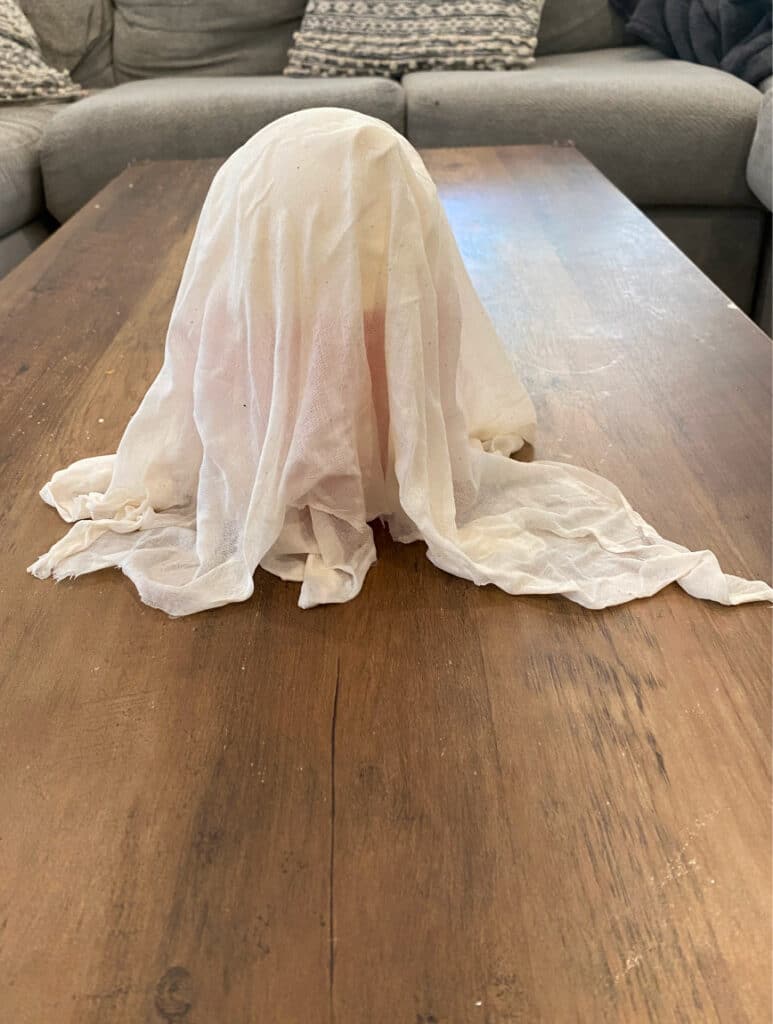
Directions


Directions
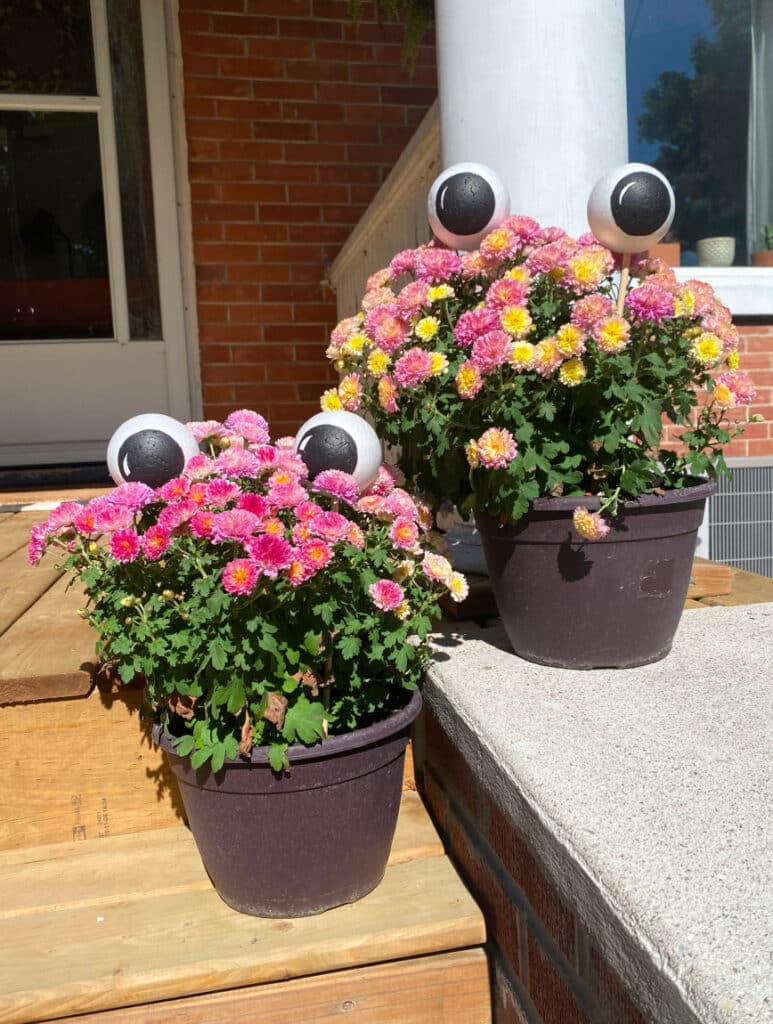
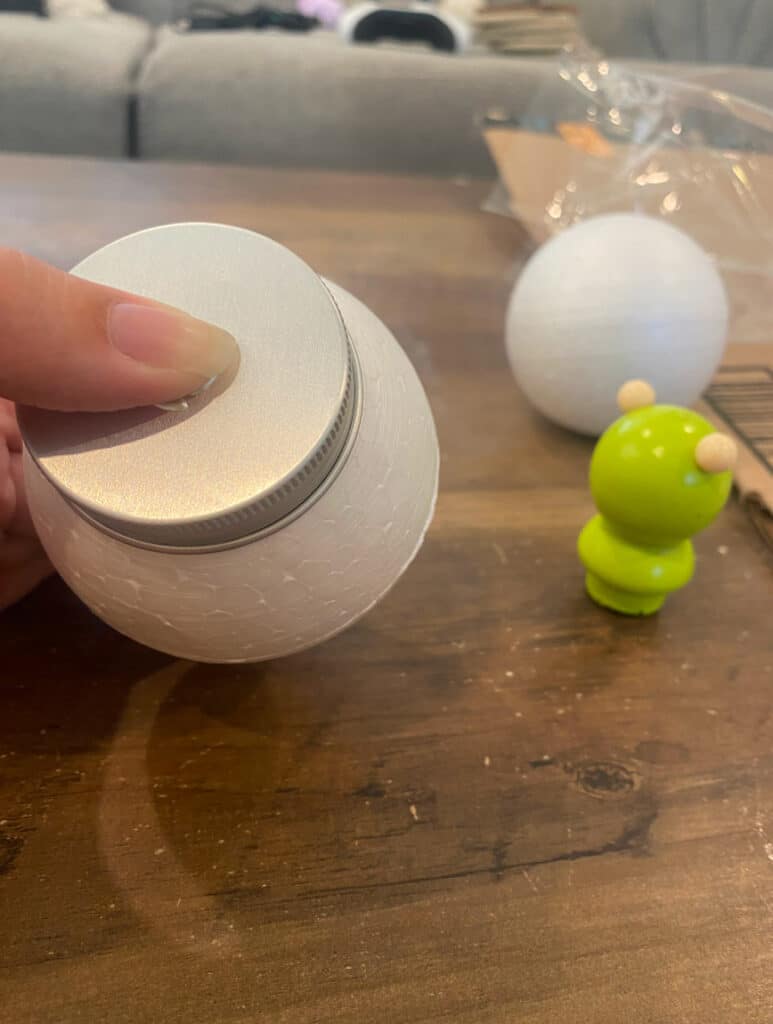


Directions

Not only will you end up with a chic, eco-friendly storage solution, but you’ll also get the satisfaction of creating something beautiful. Perfect for beginners and craft enthusiasts alike, this project promises to add a touch of handmade charm to your kitchen or pantry.

Cut macrame yarn into 8 pieces measuring about 120” long. You can tape the ends of the yarn to avoid the yarn from fraying.

Gather the 8 pieces cords and find the center. Create the handle by making a vertical row of Square Knots. Tie the Square Knots with 4 cords grouped together in the middle, 2 cords on the left, and 2 cords on the right. Make 18 vertical Square Knots to make the handle.

Tape the handle to the top of a slender water bottle. This can help to make a form for the bag’s shape. Then take two cords from each handle and tied them together in a Square Knot. Make sure you don’t space out the rows too much, keep them as close and as tights as possible.
After the rows of Square Knots reach the bottom of the water bottle, un-tape the handle and gently pull the bag up. Re-tape and continue making more Square Knots. Do this until you reach your desired length of the bag.
When finished weaving the body, make a Wrapping Knot. Trim the tassel to your desired length and fray. Start filling your produce bag with veggies or fruit of your choosing!

Show your appreciation for MOM by using your imagination and customize with your favourite shapes or colours!


Tools:
Materials:

Begin your project by tearing the coloured paper into confetti-sized pieces.
Submerge the shredded paper in water in a bowl. Allow it to soak for up to 20 minutes.
After soaking, remove the paper from the water and transfer it into the blender. Blend it until you achieve a fine, wet pulp consistency.
Squeeze out any extra moisture from the paper so it’s not dripping wet.

Press the paper halfway into your mould.

Delicately sprinkle the seeds on the paper, then cover them with another layer, filling the mould to the brim.
Patience is a virtue as you wait for the seed bombs to dry in the mould. This will take approximately 2 to 3 days.
Once fully dry, remove your seed bombs from the mould with care.
Voilà! Now you have a handful of flower-shaped seed bombs, ready to sprout into life or as a heartwarming present for Mom. The perfect gift, with love and growth wrapped into one.
Share your seed bombs using #PlantProject or tag us @plantprojectcanada and join our community.
Hoya blooms only last a few weeks, which makes it feel extra special when it does happen. If you’re having a hard time making those cute little star-shaped flowers appear, these tips will help set you up for success.

Letting the plant’s soil dry out between waterings puts a little stress on it to survive, which in turn encourages it to put out new flowers to try to ensure its survival. Rather than relying on a watering schedule to tell you when to give your hoyas a drink, touch the plant and soil. If you squeeze a leaf between your fingers and it’s squishy, time to water; if it’s firm, wait a couple days and check again. If you stick a finger in the soil and it feels dry to the touch, it’s time to water; if it feels damp, wait a few days as well.
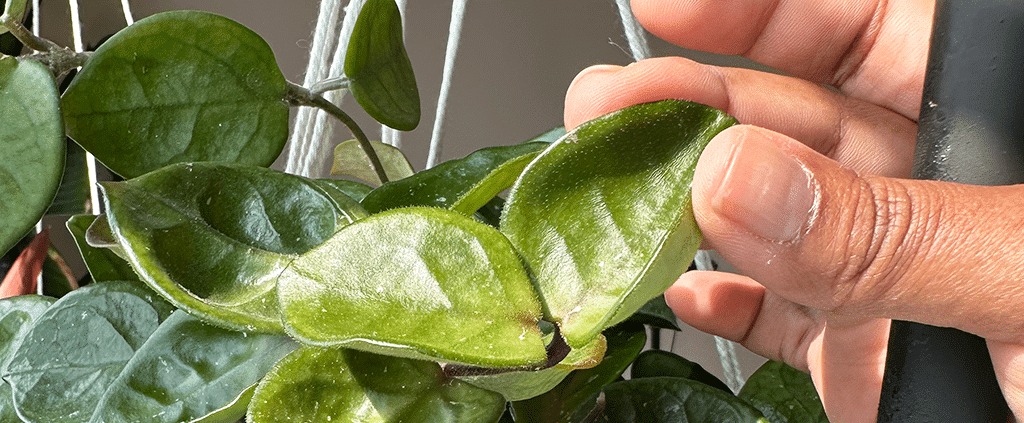
Not only are hoyas hardy plants, but hoyas are also tropicals, so they thrive in bright light. My hoyas that flower most frequently get a few hours of direct sunlight each day, and bright indirect light the rest of the day. In my experience it’s hard to give these plants too much light – if exposed to 6+ hours of direct light a day, they may even start to show the pretty patterns typical of a sun-stressed plant.

If you want a plant to put out new growth or blooms, it needs the nutrients to do so. Although you can of course use a tropical plant food the next time you water your hoya, I’ve had great luck fertilizing mine with the Miracle-Gro Ready-to-Use Orchid Plant Food Mist. Like orchids, hoyas are epiphytes. In the wild, epiphytic plants grow not in soil, but attached to other plants, and absorb water and nutrients from the air. Spraying plant food on in the form of a mist allows a hoya’s leaves to absorb those nutrients the same way they would in the wild.

The first step is to gently coax the plant out of its pot. I did this by laying to pot on its side and gently squeezing and rolling the soft plastic of the nursery pot. Then pull the plant out of the pot.

Using your fingers, begin to gently remove some of the old soil from the root ball.
Plants don’t particularly like having their roots disturbed (think about it: how often does someone come along and dig a plant up to tear apart its roots in the wild?) and being too rough can cause damage which can lead to root rot. You do want to remove some soil, though, so the roots can access the nutrients in the fresh new soil.
TLDR, gently remove as much soil as possible while doing as little damage to the roots as possible.

Grab the pot you’re planning to pot the plant in. The rule of thumb is to choose a pot that’s ~2 inches bigger than the root ball. (I decided to plant mine back in the original pot, as it was still an appropriate size, it was just the soil that needed changing.) Fill the bottom of the pot with a couple inches of soil. Then place your plant in and fill the sides and top with soil!
I like to wait a week or so after repotting before watering the plant. That way, hopefully, any root damage should form a callus and avoid root rot with the additional moisture.
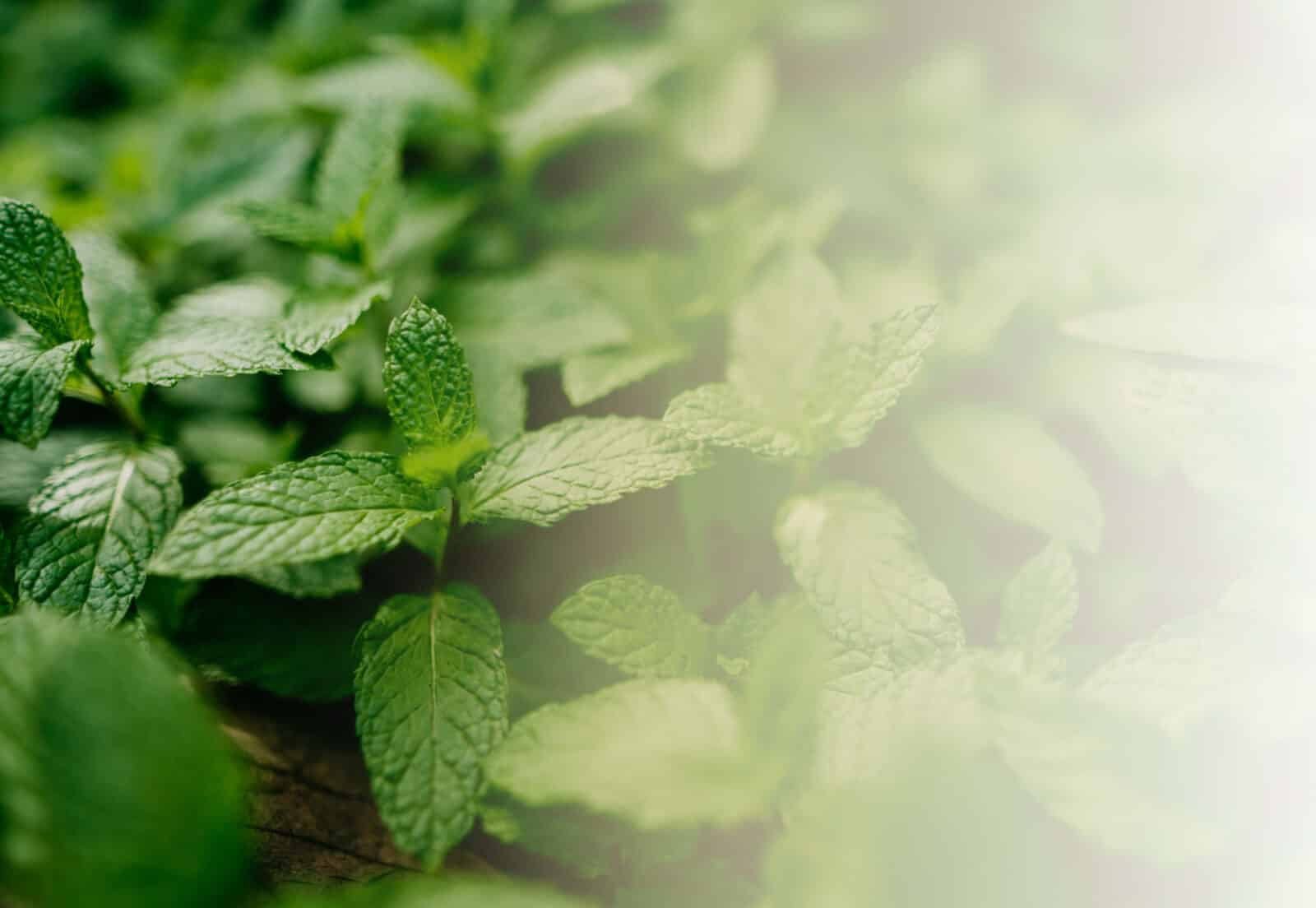
Mint is an easy, fast-growing herb that is used in drink and food recipes. It is a perennial herb that grows little white and purple flowers. There are over 30 different variations of mint, but the most commonly grown is spearmint and peppermint.
Apple/Pineapple Mint, Corsican Mint, Pennyroyal, Peppermint, Citrus Mint, Spearmint
If the soil is nice and moist, full sun is okay. Mint can also thrive in partial shade.
Should be watered at least twice a week.
This plant is safe for animals to nibble on.
Mint can grow to between 1 – 2 feet tall.
If you are prone to tension headaches, you can make a compress out of mint leaves for your forehead or rub peppermint oil on your temples.
Mint was used in ancient Greece, Rome, and Egypt

Mint does not need to be fussed over which makes it perfect for first-time gardeners. When planting your mint consider using a well-draining soil that can help with moisture control, like Miracle-Gro® All Purpose Garden Soil. This soil helps to prevent from over- and under-watering your mint plant.
Luckily, mint is an easy herb to find companion plants for. You can take your pick of popular home garden veggies such as: carrots, cabbage, kale, tomatoes, bell peppers, beans and even zucchini.
Frequent harvesting is important to keeping your mint flourishing. Young leaves have more flavour than older leaves. With this in mind, you can start harvesting your mint as soon as it comes up this spring.
If you see your mint plant drooping, there might be a pest problem. Common pests you might see with mint plants are aphids, mealy bugs, spider mites, or flea beetles. If you are seeing curling leaves or holes in your leaves, these are tell-tale signs of pests. Don’t worry, there is an easy fix. You can use a gentle insecticide like Ortho® Bug B Gon® ECO Insecticidal Soap Ready-To-Use to safely and quickly get rid of those little nuisances.


You’ve got options.
Once you pick a few sprigs from your mint plant, you can keep them in water for a few days. It is best to use your mint while it is fresh, about 3-5 days. If you are looking to dry your mint leaves, cut them right before flowering and let the leave air dry. Once dry, store the dried mint in an air-tight container.
Or you can just pick the leaves from your mint plant as you need them.
More sunlight. Most of the time, if your mint plant is looking thin and leggy it is lacking sunlight or water or nutrients. The best way to prevent mint from getting leggy is to make sure it is growing in a warm spot that gets lots of light. Keep it in a big pot with well-draining and nutrient rich soil.
Under-watering. This is easy to fix. Try watering your mint on a schedule, aiming for once or twice a week. Be sure to water under the leaves and close to the soil so you don’t damage the leaves.
Healthy, ready to use mint is a deep, rich green. If your mint is yellow and falling, it is likely due to its growing conditions. Keep your mint plant in full or partial sun, with a well-draining potting mix like Miracle-Gro® All Purpose Garden Soil. Make sure you water your mint whenever the top of the soil is dry, usually about twice a week.
But while terrarium inspo-pics are fun to look at, they can also spark that dreaded impostor syndrome within us. The thought of “can I really make something like this?” holds so many of us back from even attempting to start.
The truth is: terrariums are much simpler to create than most people think! All you need are a few base ingredients to start, and the courage to get creative.



Avant de commencer, réfléchissez au style de votre terrarium et au type de plantes que vous souhaitez y placer.
Les réponses à ces questions détermineront si vous devez opter pour un terrarium ouvert ou fermé.
Si vous souhaitez avoir des plantes tropicales qui se développent dans des conditions humides, un terrarium fermé est idéal. En revanche, si vous optez pour des petits cactus ou des plantes grasses, un terrarium ouvert est la meilleure solution.
Start by adding a 1-1.5 inch layer of pebbles, followed by a thin layer of charcoal. The pebbles act as drainage holes, while the charcoal helps reduce the amount of bad bacteria that might start developing as your plants grow.
Once you’re done, add about 2.5 inches of your potting mix. Make sure you have enough soil for your plants’ roots to fit.
Remove your plants from their original pot. Gently massage their roots to get rid of excess soil, and create small holes in your terrarium for your plant roots before carefully placing them inside.
We recommend starting with the bigger plants

Now comes the best part – decorating your terrarium.
You can add polished stones, crystals, small figurines, or any other miniature decorations to make your terrarium unique to you.
Bring out your inner child, and don’t hold back!
Carefully weave your string lights into your terrarium, making sure that they’re not getting in the way of your plants. Place your battery pack somewhere easily accessible.
Once you’re all done, turn on the lights – and watch your terrarium come to life.
Not only do string lights add a touch of mythical beauty to your creation, they also provide much needed artificial lighting to the plants inside.
Terrariums need very little upkeep to stay alive and thriving. But the amount of water they require depends on the type of terrarium you have.
Water evaporates faster in open terrariums, so they typically require a few sprays of it every couple weeks. Closed terrariums, however, retain water for much longer, so you only need to water them about twice a year.
This is the simplest seed starting method. Basically requiring sunlight and soil, it is also the method that requires the least investment (sunlight is free!).
To start seeds using this method, you need:
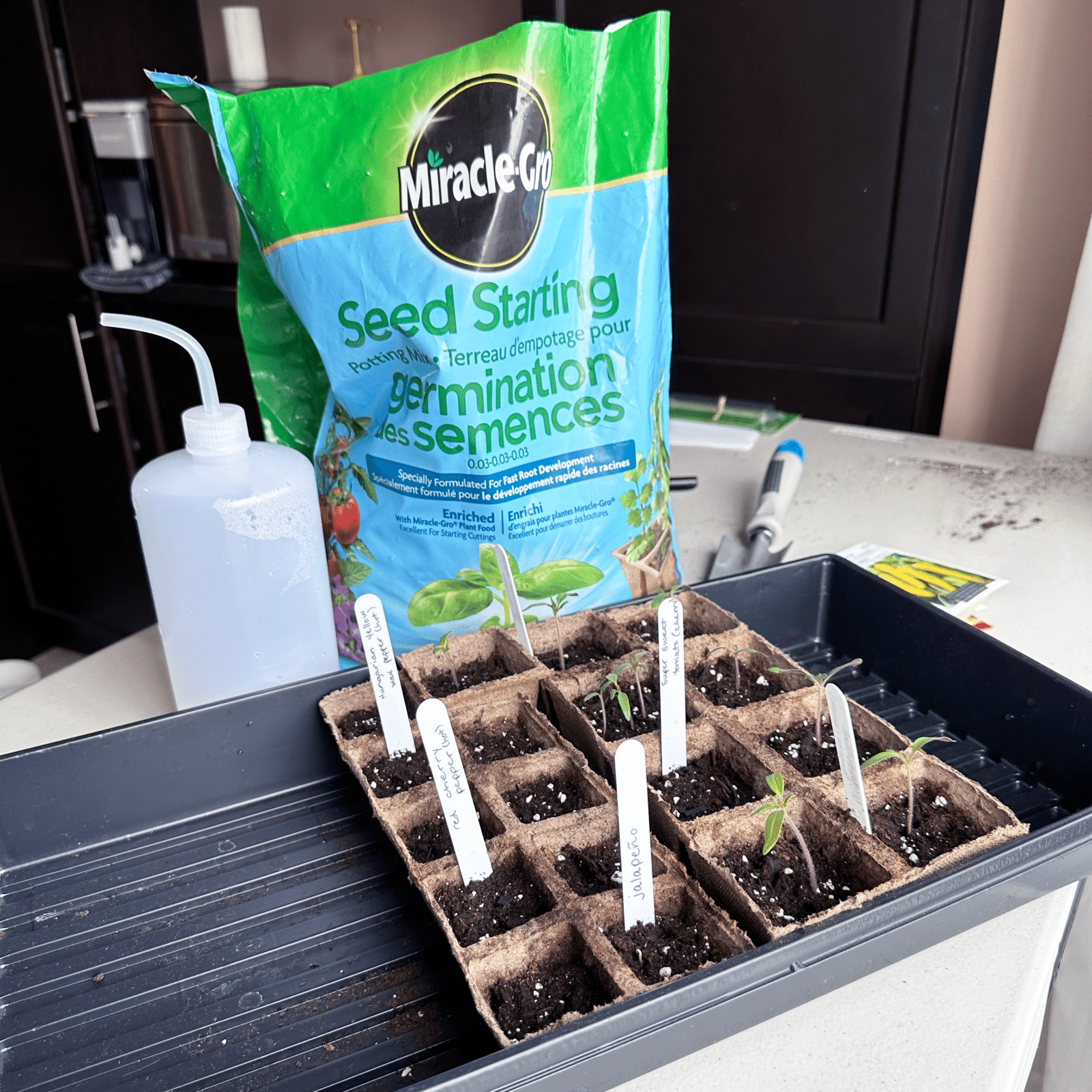
This seed starting setup is as simple as filling the pots with MiracleGro Seed Starting Potting Mix and placing a seed in each pot. Label the future seedlings with permanent marker on plant labels or popsicle sticks and place them on a sunny windowsill. Be sure to water them every day or two to keep the soil moist.
Starting seeds this way takes things up a notch by adding in a grow light. Grow lights are great because they give your plants a consistent source of light, regardless of whether the weather decides to cooperate. I love the Root Farm Grow Light because it’s large enough to fit a whole tray of seeds underneath, and it keeps the seeds on the warm side as well.
To start seeds using this method, you need:
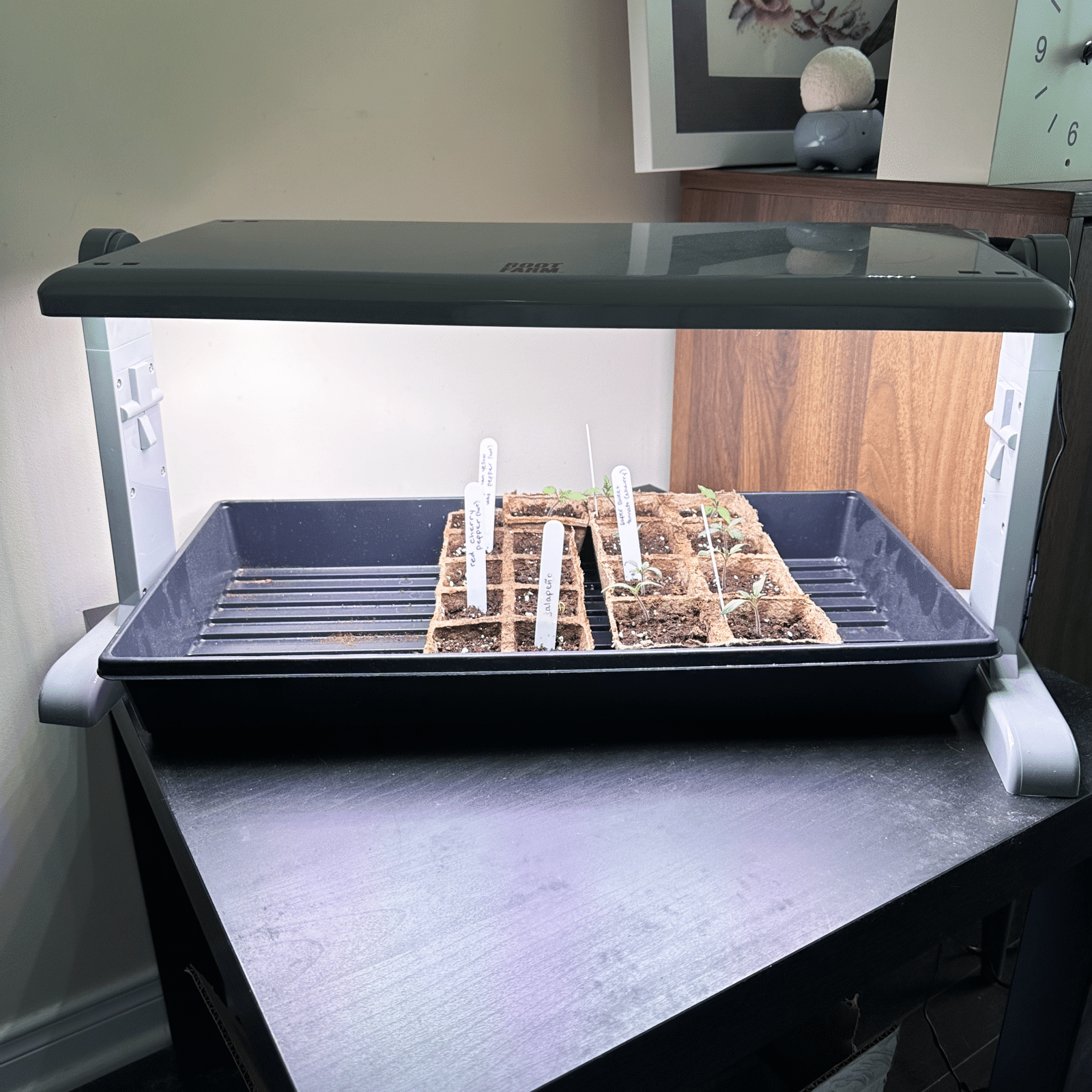
This seed starting setup is similar to the previous one. Begin by filling the pots with MiracleGro Seed Starting Potting Mix and placing a seed in each pot. Label your seedlings with permanent marker on plant labels or popsicle sticks. Assemble the Root Farm Grow Light and plug it in, placing it over the seeds. Water the seeds every one to two days to keep the soil moist.
Of these three methods, the fastest way to get your seeds to germinate is, without a doubt, the AeroGarden Seed Starting System. AeroGarden is a hydroponic growing system for 5x faster growth than soil. The AeroGarden Seed Starting System is an accessory that is sold separately from the AeroGarden, and is available for the various models (be sure to choose the Seed Starting System made specifically for your AeroGarden model.)
To start seeds with the AeroGarden Seed Starting System, you’ll need:

Begin by pre-soaking the grow sponges in water. Swap the standard AeroGarden grow deck for the Seed Starting System grow deck and place one sponge in each of the holes. Place a seed in each of the grow sponges. Plug the AeroGarden in and go follow the steps to start a garden. Fill the reservoir with water and plant food (according to directions on the back of the bottle).
For more advice and ideas on Aerogardens, visit www.aerogarden.com.
The response we saw, again and again: “When is the right time to repot my plant?”
We understand the confusion. Knowing when a plant needs to be repotted isn’t the same as knowing when you should get a bigger pair of jeans. There’s more nuance and complexity to the decision.
Which is why we put together a handy-dandy checklist to help you figure out if your plant needs a bigger pot, or not.
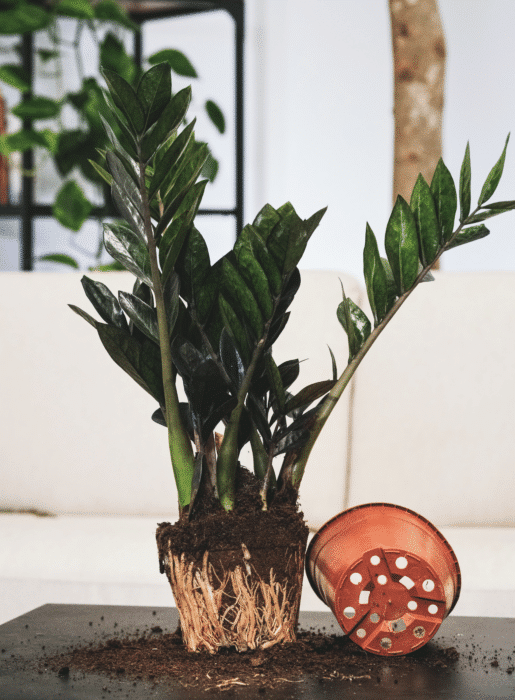
If so, it’s a clear sign that they have no more room to grow in their current planter, and need a larger one, ASAP.
When they’ve run out of space, roots can begin to grow upward in search of more soil and nutrients. This can push the plant up, and make it look like it’s almost coming out of its pot.
Yes, winter dormancy is a thing. But if you’re noticing a significant lack of growth, this could be a sign that your plants simply don’t have enough space to continue thriving.
Once your plant has grown larger than its own pot, it’s likely to start tipping over. Which is when you know you need a bigger, wider pot to help it maintain stability as it grows.

Growing plants have a need for extra nutrients and water. So if you’re noticing their soil getting dry faster, that means it’s time to transition to a pot that will facilitate your plant’s steady growth.
Ideally, your pot should be half the size of your plant. If your plant becomes triple its size or more, it needs extra space – or else its growth will be inhibited.
That’s salt and mineral buildup – which is a clear indication that your plant needs more nutrients, and potentially a bigger pot with fresh soil.

Rule of thumb: repot your plant at least once every year! It’ll spur new growth, and keep your plant healthy and happy.
It is recommended selecting planters and pots with drainage, especially if you are new to watering plants. It’s totally possible to make planters without drainage work with a little finesse! A good tip to remember is to pour no more than 1/3 of the container’s size in water. Lining the bottom of a planter with lava rocks or similar to create crevices for excess water to drain into is a great way to avoid root rot.

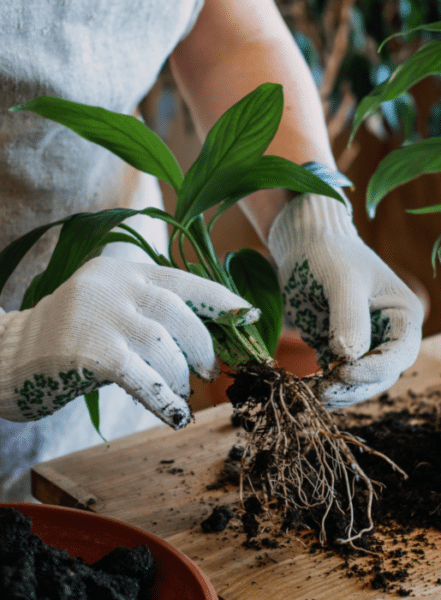
Turn your plant sideways, hold it gently by its stems, and tap the bottom of its pot until the plant slides out.
Loosen your plant’s roots by massaging it gently with your fingers.

Scoop in a nutrient-rich, well-draining potting mix into your new plant pot, until it fills a third of the pot. We recommend Miracle-Gro® Indoor Potting Mix – it feeds your plant for up to 6 months!
Place your plant into the new pot, filling it in with more potting mix. Look at that – you’re only one step away from being done!
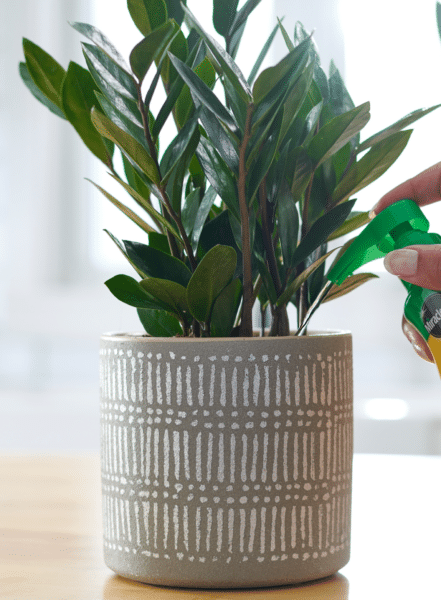
Give your plant a good watering, and add some Miracle-Gro® Indoor Plant Food for an extra nutrient boost.
To learn more about which material and size of planter you should be getting for your plant’s repotting, read this article!
Sounds easy right? Then why doesn’t your plant collection look like it’s getting enough water? The answer is easy, overhead watering may not be saturating your plant’s soil. The solution: Try bottom watering.

Bottom watering plants is a method of watering that waters potted plants from the bottom up. The plant is placed in a tray or container of water and absorbs water via capillary action through the holes in the bottom of the pot.
Instead of dumping liquid onto the top of the soil of your container plants, you allow the soil to soak it up into its roots from the drainage holes in the bottom of the pot.

Bottom watering helps you to avoid drowning your plants in their pot. The soil will only absorb as much moisture as it can hold. It also prevents certain pests, because the top layer of soil will stay dry when watering your plant.
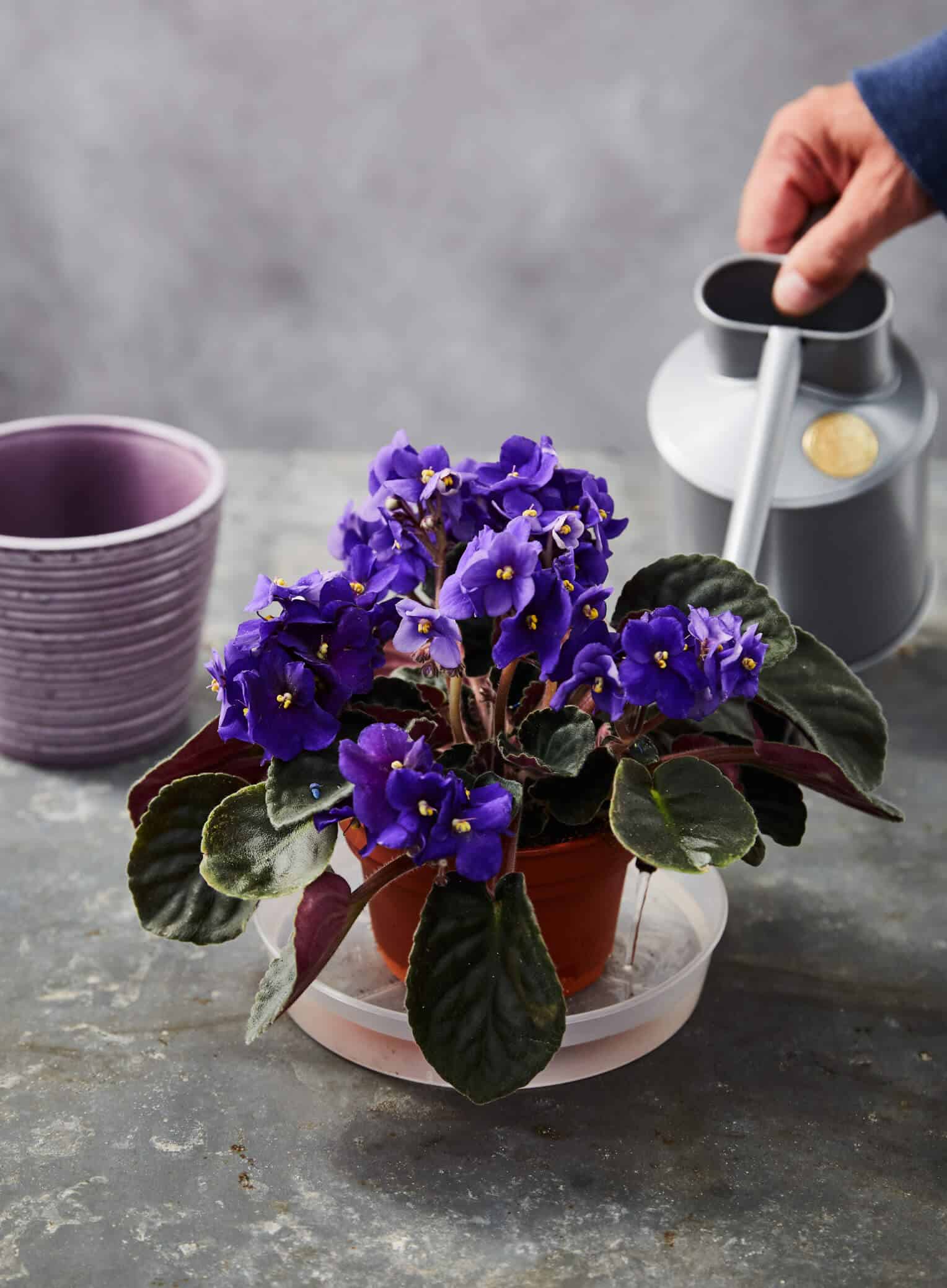
Yes, if the plant is sitting in water too long, you can still overwater your plant through bottom watering. However, bottom watering is a more controlled method of watering your plants. Just make sure your plant is in a nursery pot or a pot with drainage holes.
If you’re finding that your plants are bigger than any bowl you have, you can fill a nursery tray or even your kitchen sink with water to sit your plant in.
log in to join the plant chat!
join our passionate plant community and gro your garden!
By registering, I am allowing Scotts Canada Ltd. to contact me with news, articles and promotions. I understand that I can withdraw my consent at any time.